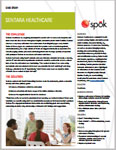Case studies
Sentara Healthcare
Overview
Sentara Healthcare is a nonprofit health system serving Virginia and northeastern North Carolina. Based in Norfolk, Va., Sentara operates 12 acute care hospitals, as well as advanced imaging centers, nursing and assisted-living centers, outpatient campuses, physical therapy and rehabilitation services, home health and hospice agencies, a 3,800-provider medical staff, and five medical groups. In addition, Sentara provides medical transport ambulances and a Nightingale air ambulance. It also extends health insurance to 450,000 people through Optima Health, its award-winning health plan. To learn more about Sentara Healthcare, visit www.sentara.com.
Industry
- Healthcare
Business drivers
- Improve call center efficiency in handling increasingly complex operator functions
- Boost staff productivity through better organization of directory and consistent, intuitive information sharing
- Give clinicians more time with their patients
Solution
- Secure messaging, professional services
Results
- Increased paging throughput for greater call center efficiency
- Expanded understanding of system functions, options, and features to enhance operator workflows
- Improved patient care
The challenge
Sentara Healthcare is a regional, not-for-profit system with 12 acute care hospitals and more than 100 sites of care throughout Virginia and northeastern North Carolina. Sentara also has a very busy call center that sends more than 300,000 pages every month. Some of these pages are automated alerts for systems such as bed management and maintenance, but a high volume of them are triggered manually by operators. The sizeable paging volume plus code call management and the large number of operator calls prompted Sentara to reevaluate call center workflows.
Sentara had been using Spok console and web directory solutions for nearly a decade, and the IT and call center departments decided it would be worthwhile to take a closer look at how the call center was functioning. “We wanted to know if we were using our console and web products in the best way possible for staff workflow,” said Greg Walkup, a director in the IT department, “and if there were ways we could be more efficient. So we turned to Spok for help.”
The solution
Sentara worked with Spok Services team for an in-depth evaluation to help with three primary goals:
- Evaluate efficiencies within the call center
- Increase physician and nurse usage of the online employee directory
- Assess the organization of data in the database
“From how we’re set up to the operation of our systems, we wanted to know if there were functions we weren’t using and if we could modify our process for better results,” explained Walkup. The engagement included discussions on establishing goals and expectations, conducting a visit, and creating a full report with findings and suggestions.
Although we’ve just begun to implement changes, the consulting engagement has already been an excellent use of our time and resources. It has been really worthwhile to uncover some things we didn’t know about.
– Greg Walkup, Director of IT
The result
During the visit, Walkup was impressed with the depth of knowledge about call center product capabilities and workflows demonstrated by Brenda Wurst, Global Head of Services at Spok. “Brenda asked us a question about our port set-up during the evaluation, and it was something we were not aware could be manipulated. We saw value immediately because we were able to expand the bandwidth for our console solution and increase throughput when sending out pages.”
Walkup mentioned that there were also several other items they were able to take direct action on as a result of the consulting visit, and that Brenda’s questions and suggestions gave Sentara a return on their investment before they even received the final report.
Spok delivered the findings report a few weeks after the visit. It contained general workflow suggestions and 15 specific items pinpointing where Sentara could improve productivity, cut costs, save time, or use Spok solutions more efficiently. “Although we’ve just begun to implement changes, the consulting engagement has already been an excellent use of our time and resources,” said Walkup. “It has been really worthwhile to uncover some things we didn’t know about. We’re also considering bringing Services back to do a deep dive into the clinical communications at one of our hospitals and work with our physician interruption steering committee on the Spok Mobile® deployment at that location.”
In addition to their call center questions, Sentara has been working on an initiative to roll out secure messaging to more administrators and physicians throughout the system to relieve messages directly from clinicians. The advantage of Spok Mobile over standard texting or paging techniques is that clinicians can include electronic protected health information (ePHI) about a patient and still be HIPAA compliant.
“With Spok Mobile, our physicians determined what information they wanted included in pages to make alerts more actionable,” said Walkup. “In contrast to just a call-back number, physicians using the app now get enough information to go into the EMR and fulfill a request, saving the time and hassle of calling someone to get more detailed information.” Walkup continued to say that in the hospitals where Spok Mobile is used it has improved clinician and call center workflows. “Staff used to call operators to page doctors. Now clinicians can search the directory for the person they need and send an actionable request directly. This has significantly reduced the number of physician call-backs for information, which gives clinicians more time with their patients.” Walkup expects that working with Spok on additional rollouts of the mobile app will help more providers see the instant benefits of using the online directory and secure texting: improved efficiency, more time with patients, and better patient care.




